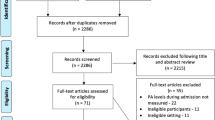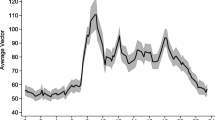Abstract
Background
The assessment of physical activity levels of hospitalised older people requires accurate and reliable measures. Physical activities that older people in hospital commonly engage in include exercises and walking. Measurement of physical activity levels of older inpatients is essential to evaluate the impact of interventions to improve physical activity levels and to determine associations between physical activity in hospital and other health-related outcome measures.
Objective
To determine which measures are used to measure physical activity of older people in hospital, and to describe their properties and applications.
Method
A systematic review of four databases: Medline, Embase, CINAHL and AMED was conducted for papers published from 1996 to 2016. Inclusion criteria were participants aged ≥ 65 years and studies which included measures of physical activity in the acute medical inpatient setting. Studies which specifically assessed the activity levels of surgical patients or patients with neurological conditions such as stroke or brain injury were excluded. All study designs were included in the review.
Results
18 studies were included from 127 articles selected for full review. 15 studies used objective measures to measure the physical activity of older inpatients: 11 studies used accelerometers and four used direct systematic observations. Seven accelerometers were identified including the StepWatch Activity Monitor, activPAL, GENEActiv, Kenz Lifecorder EX, Actiwatch-L, Tractivity and AugmenTech Inc. Pittsburgh accelerometer. Three studies used a subjective measure (interviews with nurses and patients) to classify patients into low, intermediate and high mobility groups. The StepWatch Activity Monitor was reported to be most accurate at step-counting in patients with slow gait speed or altered gait. The activPAL was reported to be highly accurate at classifying postures.
Conclusion
Physical activity levels of older inpatients can be measured using accelerometers. The accuracy of the accelerometers varies between devices and population-specific validation studies are needed to determine their suitability in measuring physical activity levels of hospitalised older people. Subjective measures are less accurate but can be a practical way of measuring physical activity in a larger group of patients.






Similar content being viewed by others
References
Lafont C, Gerard S, Voisin T, et al. Reducing «iatrogenic disability» in the hospitalized frail elderly. The journal of nutrition, health & aging. 2011;15(8):645–660.
Brown CJ, Redden DT, Flood KL, et al. The underrecognized epidemic of low mobility during hospitalization of older adults. Journal of the American Geriatrics Society. 2009;57(9):1660–1665.
Bodilsen A, Pedersen M, Petersen J. Acute Hospitalization of the Older Patient. American Journal of Physical Medicine & Rehabilitation. 2013;92:789–796.
Fisher S, Goodwin J, Protas EJ, et al. Ambulatory Activity of Older Adults Hospitalized with Acute Medical Illness. Journal of the American Geriatrics Society. 2011;59(1):91–95.
Caspersen C, Powell K, Christenson G. Physical activity, exercise, and physical fitness: definitions and distinctions for health-related research. Public health reports (Washington, D.C.: 1974). 1985;100(2):126–131.
Pahor M, Guralnik JM, Ambrosius WT, et al. Effect of structured physical activity on prevention of major mobility disability in older adults: The life study randomized clinical trial. JAMA. 2014;311(23):2387–2396.
Brown CJ, Friedkin RJ, Inouye SK. Prevalence and outcomes of low mobility in hospitalized older patients. Journal of the American Geriatrics Society. 2004;52(8):1263–1270.
Zisberg A, Shadmi E, Sinoff G, et al. Low mobility during hospitalization and functional decline in older adults. Journal of the American Geriatrics Society. 2011;59(2):266–273.
Kosse NM, Dutmer AL, Dasenbrock L, et al. Effectiveness and feasibility of early physical rehabilitation programs for geriatric hospitalized patients: a systematic review. BMC Geriatrics. 2013;13:107–107.
Brown CJ, Foley KT, Lowman JD, et al. Comparison of posthospitalization function and community mobility in hospital mobility program and usual care patients a randomized clinical trial. JAMA Internal Medicine. 2016;176(7):921–927.
Martínez-Velilla N, Cadore EL, Casas-Herrero Á, et al. Physical activity and early rehabilitation in hospitalized elderly medical patients: Systematic review of randomized clinical trials. The journal of nutrition, health & aging. 2016;20(7):738–751.
DiPietro L. The epidemiology of physical activity and physical function in older people. Medicine & Science in Sports & Exercise. 1996;28(5):596–600.
Colbert LH, Matthews CE, Havighurst TC, et al. Comparative validity of physical activity measures in older adults. Medicine and Science in Sports and Exercise. 2011;43(5):867–876.
Bassett DR, Dinesh J. Use of pedometers and accelerometers in clinical populations: validity and reliability issues. Physical Therapy Reviews. 2010;15(3):135–142.
Downs SH, Black N. The feasibility of creating a checklist for the assessment of the methodological quality both of randomised and non-randomised studies of health care interventions. Journal of Epidemiology and Community Health. 1998;52(6):377–384.
Rowlands AV, Olds TS, Hillsdon M, et al. Assessing sedentary behavior with the geneactiv: Introducing the sedentary sphere. Medicine and Science in Sports and Exercise. 2014;46(6):1235–1247.
Fisher SR, Graham JE, Brown CJ, et al. Factors that differentiate level of ambulation in hospitalised older adults. Age and ageing. 2012;41(1):107–111.
Fisher SR, Kuo YF, Graham JE, et al. Early ambulation and length of stay in older adults hospitalized for acute illness. Archives of Internal Medicine. 2010;170(21):1942–1943.
Ostir GV, Berges IM, Kuo YF, et al. Mobility activity and its value as a prognostic indicator of survival in hospitalized older adults. Journal of the American Geriatrics Society. 2013;61(4):551–557.
Taraldsen K, Askim T, Sletvold O, et al. Evaluation of a Body-Worn Sensor System to Measure Physical Activity in Older People With Impaired Function. Physical Therapy. 2011;91(2):277–285.
Pedersen MM, Bodilsen AC, Petersen J, et al. Twenty-four-hour mobility during acute hospitalization in older medical patients. Journals of Gerontology Series A-Biological Sciences & Medical Sciences. 2012;68(3):331–337.
Vinzio S, Ruellan A, Perrin A, et al. Actigraphic assessment of the circadian restactivity rhythm in elderly patients hospitalized in an acute care unit. Psychiatry and Clinical Neurosciences. 2003;57(1):53–58.
Sallis R, Roddy-Sturm Y, Chijioke E, et al. Stepping toward discharge: Level of ambulation in hospitalized patients. Journal of Hospital Medicine. 2015;10(6):384–389.
Izawa KP, Watanabe S, Oka K, et al. Differences in daily in-hospital physical activity and geriatric nutritional risk index in older cardiac inpatients: preliminary results. Aging clinical and experimental research. 2014;26(6):599–605.
Mudge AM, Giebel AJ, Cutler AJ. Exercising body and mind: An integrated approach to functional independence in hospitalized older people. Journal of the American Geriatrics Society. 2008;56(4):630–635.
Boltz M, Resnick B, Capezuti E, et al. Functional Decline in Hospitalized Older Adults: Can Nursing Make a Difference? Geriatric Nursing. 2012;33(4):272–279.
Doherty-King B, Yoon JY, Pecanac K, et al. Frequency and duration of nursing care related to older patient mobility. Journal of Nursing Scholarship. 2013;46(1):20–27.
Mudge AM, McRae P, McHugh K, et al. Poor mobility in hospitalized adults of all ages. Journal of Hospital Medicine. 2016;11(4):289–291.
Cavanaugh JT, Coleman KL, Gaines JM, et al. Using Step Activity Monitoring to Characterize Ambulatory Activity in Community-Dwelling Older Adults. Journal of the American Geriatrics Society. 2007;55(1):120–124.
Storti KL, Pettee KK, Brach JS, et al. Gait speed and step-count monitor accuracy in community-dwelling older adults. Medicine and science in sports and exercise. 2008;40(1):59–64.
Bergman RJ, Bassett DR, Muthukrishnan S, et al. Validity of 2 devices for measuring steps taken by older adults in assisted-living facilities. Journal of physical activity & health. 2008;5 Suppl 1:S166–S175.
Foster RC, Lanningham-Foster LM, et al. Precision and accuracy of an ankle-worn accelerometer-based pedometer in step counting and energy expenditure. Preventive Medicine. 2005;41(3–4):778–783.
Storti KL, Pettee KK, Brach JS, et al. Gait speed and step-count monitor accuracy in community-dwelling older adults. Medicine and science in sports and exercise. 2008;40(1):59–64.
McDonald CM, Widman LM, Walsh DD, et al. Use of step activity monitoring for continuous physical activity assessment in boys with Duchenne muscular dystrophy. Archives of physical medicine and rehabilitation. 2005;86(4):802–808.
Bjornson KF, Belza B, Kartin D, et al. Ambulatory Physical Activity Performance in Youth With Cerebral Palsy and Youth Who Are Developing Typically. Physical Therapy. 2007;87(3):248–257.
Sandroff BM, Motl RW, Pilutti LA, et al. Accuracy of StepWatch™ and ActiGraph accelerometers for measuring steps taken among persons with multiple sclerosis. PloS one. 2014;9(4):e93511–e93511.
Mudge S, Stott NS, Walt SE. Criterion validity of the StepWatch Activity Monitor as a measure of walking activity in patients after stroke. Archives of physical medicine and rehabilitation. 2007;88(12):1710–1715.
Wendland DM, Sprigle SH. Activity monitor accuracy in persons using canes. Journal of Rehabilitation Research and Development. 2012;49(8):1261–1268.
Grant PM, Dall PM, Mitchell SL, et al. Activity-monitor accuracy in measuring step number and cadence in community-dwelling older adults. Journal of aging and physical activity. 2008;16(2):201–214.
Landry GJ, Falck RS, Beets MW, et al. Measuring physical activity in older adults: calibrating cut-points for the MotionWatch 8. Frontiers in Aging Neuroscience. 2015;7:165.
Koizumi D, Rogers NL, Rogers ME, et al. Efficacy of an accelerometer-guided physical activity intervention in community-dwelling older women. J Phys Act Health. 2009;6(4):467–474.
Crouter S, Schneider P, Karabulut M, et al. Validity of 10 Electronic Pedometers for Measuring Steps, Distance, and Energy Cost. Medicine & Science in Sports & Exercise. 2003;35(8):1455–1460.
Zisberg A, Shadmi E, Gur-Yaish N, et al. Hospital-Associated Functional Decline: The Role of Hospitalization Processes Beyond Individual Risk Factors. Journal of the American Geriatrics Society. 2015;63(1):55–62.
Graham E, Fisher SR, Berges I-m, et al. Walking Speed Threshold for Classifying Walking Independence in Hospitalized Older Adults. Physical Therapy. 2010;90(11):1591–1598.
McKenzie TL. The use of direct observation to assess physical activity. In: welk G, ed. Physical Activity Assessments for Health-Related Research: Human Kinetics; 2002:179–195.
Sallis JF, Saelens BE. Assessment of physical activity by self-report: status, limitations, and future directions. Research quarterly for exercise and sport. 2000;71(2 Suppl):S1–14.
Shephard RJ. Limits to the measurement of habitual physical activity by questionnaires. British Journal of Sports Medicine. 2003;37(3):197–206.
Esliger DW, Rowlands AV, Hurst TL, et al. Validation of the GENEA Accelerometer. Med Sci Sports Exerc. 2011;43(6):1085–1093.
Phillips LRS, Parfitt G, Rowlands AV. Calibration of the GENEA accelerometer for assessment of physical activity intensity in children. Journal of Science and Medicine in Sport. 2013;16(2):124–128.
Zhang S, Murray P, Zillmer R, et al. Activity classification using the GENEA: optimum sampling frequency and number of axes. Med Sci Sports Exerc. 2012;44(11):2228–2234.
Zhang S, Rowlands AV, Murray P, et al. Physical activity classification using the GENEA wrist-worn accelerometer. Med Sci Sports Exerc. 2012;44(4):742–748.
Grant PM, Ryan CG, Tigbe WW, et al. The validation of a novel activity monitor in the measurement of posture and motion during everyday activities. British Journal of Sports Medicine. 2006;40(12):992–997.
Lyden K, Kozey Keadle SL, et al. Validity of two wearable monitors to estimate breaks from sedentary time. Med Sci Sports Exerc. 2012;44(11):2243–2252.
Brown CJ, Roth DL, Allman RM. Validation of use of wireless monitors to measure levels of mobility during hospitalization. Journal of Rehabilitation Research and Development. 2008;45:551–558.
Levine B, Moyles T, Roehrs J, et al. Actigraphic monitoring and polygraphic recording in determination of sleep and wake. Sleep Research. 1986;15:247.
Cole R, Kripke D, Gruen W, et al. Automatc sleep/wake identification from wrist actigraphy. 1992. 1992;15:461–469.
Schneider PL, Crouter SE, Lukajic O, et al. Accuracy and Reliability of 10 Pedometers for Measuring Steps over a 400-m Walk. Medicine & Science in Sports & Exercise. 2003;35(10):1779–1784.
Kuys SS, Dolecka UE, Guard A. Activity level of hospital medical inpatients: An observational study. Archives of gerontology and geriatrics. 2012;55(2):417–421.
Kramer SF, Cumming T, Churilov L, et al. Measuring Activity Levels at an Acute Stroke Ward: Comparing Observations to a Device. BioMed Research International. 2013;2013:8.
Author information
Authors and Affiliations
Corresponding author
Rights and permissions
About this article
Cite this article
Lim, S.E.R., Ibrahim, K., Sayer, A.A. et al. Assessment of Physical Activity of Hospitalised Older Adults: A Systematic Review. J Nutr Health Aging 22, 377–386 (2018). https://doi.org/10.1007/s12603-017-0931-2
Received:
Accepted:
Published:
Issue Date:
DOI: https://doi.org/10.1007/s12603-017-0931-2




